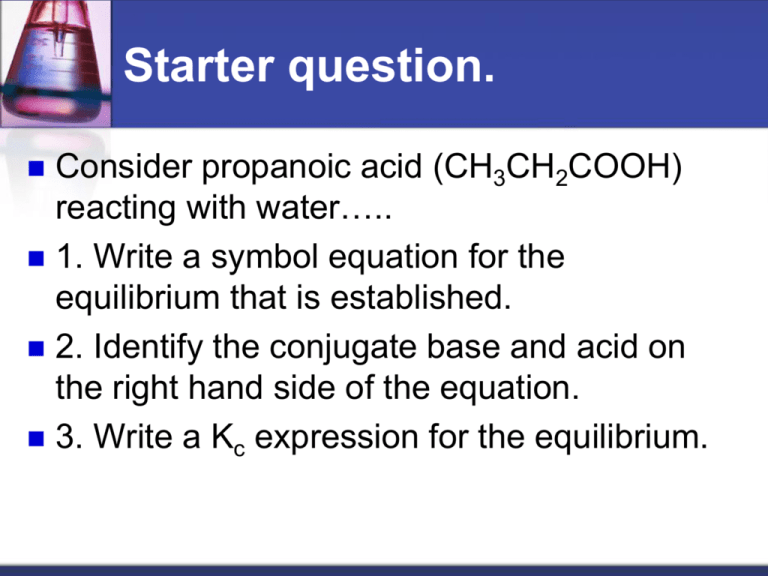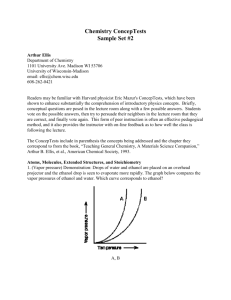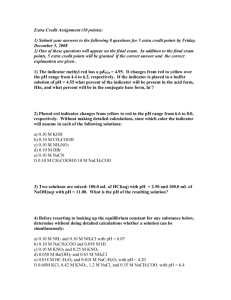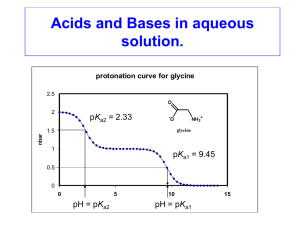CI 8.2 Strong and Weak Acids
advertisement

Starter question. Consider propanoic acid (CH3CH2COOH) reacting with water….. 1. Write a symbol equation for the equilibrium that is established. 2. Identify the conjugate base and acid on the right hand side of the equation. 3. Write a Kc expression for the equilibrium. Starter answers CH3CH2COOH (aq) + H20(l) ↔ H3O+(aq) + CH3CH2COO-(aq) Conjugate base….CH3CH2COOConjugate acid H3O+ Ka = [H+(aq)][CH3CH2COO-(aq)] [CH3CH2COOH (aq)] The pH scale The pH scale Devised by a Danish chemist called Soren Sorensen. It indicates how much acid or alkali is present in a solution. The ‘p’ in pH stands for ‘potens’, which is latin for power. pH = -log[H+ (aq)] Calculating the pH of a strong acid. Calculating the pH of a strong acid The pH of strong acids are relatively simple to calculate. If we assume that the acid molecules fully dissociate then [H+] = [HA] Therefore pH = -log [HA] E.g. 1 mol HCl, pH = –log[1] = 0 E.g. 0.1 mol HCl, pH = -log[0.1] = 1 Calculating the pH of a weak acid. Calculating the pH of a weak acid. An example. What is the pH of 0.1moldm-3 ethanoic acid, which has a Ka of….1.74X105moldm-3?) You need to… 1. Write out the equilibrium expression (Ka) 2. convert hydrogen concentration [H+] to pH Step 1 the Ka expression. Equilibrium equation. CH3COOH (aq) ↔ H+ (aq) + CH3COO-(aq) So the general Ka expression will be…… Ka = [CH3COO-(aq)][H+(aq)] [CH3COOH(aq)] But we need to consider when full equilibrium has been reached and take account of our initial concentration of acid. Step 2 the equilibrium position. CH3COOH ↔ H+ + CH3COO- CH3COOH H+ CH3COO- Start Conc. 0.100 0 0 At equilibrium. 0.100- [CH3COO-] [H+] [CH3COO-] CH3COOH H+ CH3COO- For every ethanoic acid molecule that dissociates an ethanoate ion and a H+ also forms. Writing the new Ka expression at equilibrium. COO-(aq)] [H+ (aq)] Initial concentration minus the dissociation concentration of the ions. Ka = [CH3 eq eq 0.100 – [CH3COO-(aq)]eq As [CH3COO-] = [H+] at equilibrium we can write… Ka = [H+]2 0.100 – [H+] Because the disassociation of the weak acid is so small we assume 0.100 – [H+] = 0.100 Plugging the numbers in.. Substituting in the values gives…. 1.74 X 10-5 = [H+]2 0.100 [H+]2= 0.100 X 1.74 X 10-5 [H+] = √(1.74 X 10-6) [H+]= 1.319 X 10-3moldm-3 = pH = 2.88 (using –log) Comparing strong and weak acids Factors Strong Acid Weak Acid [H+ (aq)] becomes 100 x smaller [H+ (aq)] becomes 10 x smaller pH increases by 2 pH increases by 1 Conductivity Higher as more free ions Lower as less free ions. Reaction Rate Reacts far quicker due to greater dissociation Reacts slower as relies on H+ being removed from equilibrium to completely dissociate acid molecules. Acid diluted by a factor of 100 Strength vs. Concentration Concentration is a measure of the amount of substance in a given volume of solution. Strength is a measure of the extent to which an acid can donate H+. Measured as pKa values: pKa = -log Ka Calculating the pH of a strong base. Calculating pH of a strong base. To begin with we need to understand another term, Kw, this is the ionic product of water. For water, Ka = [H+(aq)] [OH-(aq)] / [H2O(l)] As water is always present in excess we ignore the term, [H2O(l)] to give: Kw = [H+(aq)] [OH-(aq)] At 298K Kw = 1x10-14 mol2 dm-6 Calculating pH of a strong base. Kw = [H+(aq)] [OH-(aq)] At 298K Kw = 1x10-14 mol2 dm-6 Kw = 1x10-14 = [H+]2 Therefore [H+] = 1x10-7 =pH7 at 298K, pH will fall as temperature increases. Calculating pH of a strong base. What is the pH of a 0.1 mol solution of sodium hydroxide? Kw = 1 x 10-14 = [H+] x [OH-] Kw = 1 x 10-14 = [H+] x [0.1] [H+] = 1 x 10-14 / 0.1 [H+] = 1 x 10-13 pH = -log [1 x 10-13] = 13









